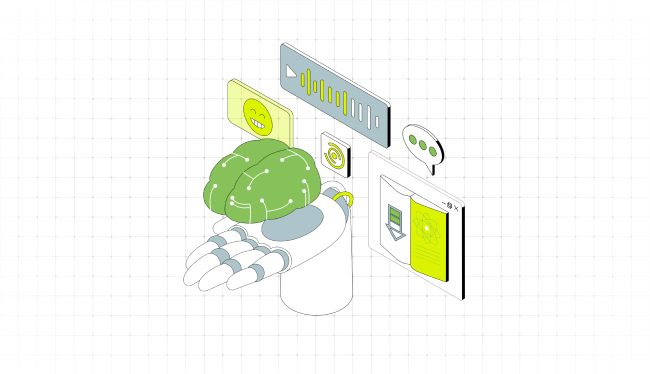Topics
Charting Success: Driving Workforce Transformation

Many companies are increasingly overwhelmed by how to take advantage of emerging technologies like extended reality (XR) and generative AI. To grow and stay competitive, they need to get up to speed, and they need to do it fast. But how? And where should they start?
This is where immersive learning leads the charge. This practical use case has a real and tangible effect on the bottom line by enabling companies to more efficiently and effectively train their workforces.
Understanding Digital Transformation in the Workplace
Digital transformation refers to a digital-first approach to all systems, processes, and customer experiences. It uses data, tech and AI tools to enhance workflows and scalability, which ultimately help drive results and efficiency.
Digital transformation isn’t a one-and-done solution. It’s a long-term commitment to rewiring how an enterprise evolves and improves over time. This means ongoing system updates, assessments of procedures, and continually adapting to new technologies.
Anticipate Shifts in the Workplace
Workers perform differently today compared to 10 or 20 years ago. Between a greater emphasis on work-life balance, the rise of hybrid and remote workforces, and employers prioritizing skills over educational background, the world of work continues to change.
This is due in part to advancements in technology, but we’ve also seen a recent shift in the priorities and values of modern workers. CGS surveyed 1,000 US workers to gauge their reception to AI tools in the workplace, their self-learning skills, and how college affects their experience in the workplace.
The report shows that only one-third of employees think college provides specific expertise when going into the workforce. It seems the most value comes from soft skills that aren’t usually the focus of a college education. Soft skills like teamwork, emotional intelligence, and problem-solving are often learned on the job or through hands-on experience.
More than half of those surveyed view AI and automation as positive tools to help them in their jobs. As industries and technology change, so do workers. While there are still those hesitant to face AI tech head-on, successful organizations will need to adjust accordingly to ensure optimized results.
Immersive Learning for Employee Training
Part of the equation for business growth involves embracing new technology and industry advancements. Adapting to innovative tech, like automation, machine learning and AI, can produce positive outcomes within employee training programs, such as higher levels of confidence performing tasks and duties in the flow of work; and the ability to practice, test, and fail fast in safe spaces within immersive environments and work scenarios.
AI expands the possibilities of soft skills training, while XR uses technology to create virtual experiences alongside the real world. Augmented reality (AR), specifically, brings interaction to immersive learning.
This interactive aspect of AR has a leg up on traditional training techniques. Coaching requires ongoing engagement from time-strapped SMEs, and quizzes often lack variety and engagement. This means learners don’t retain as much knowledge as they should. Generative AI allows enterprises to customize training programs to target specific real-life situations. Immersive role-playing encourages teams to learn in safe spaces and master necessary workplace skills by acting out a myriad of dynamic scenarios.
CGS partners with companies to create immersive learning environments through XR catered to specific audiences and goals. Flight attendants, for example, need to learn how to handle unruly passengers. They can do so by using an AI-powered XR simulation programmed to imitate this type of scenario. By using generative AI and immersive simulations, workers can practice customer service tactics and interpersonal soft skills, and they can express industry knowledge with a chatbot programmed to respond.
This style of training is also highly adaptable across all areas of the business. Sales teams, leadership teams, customer service, and technical support benefit from incorporating AI and XR into workplace transformation. Companies can adapt the technology to work in their favor, no matter what role or level of coaching and training is needed.
Focus on Business Agility
If you haven’t figured it out yet, the name of the game is change specifically, embracing change as it happens. That’s why business agility—your ability to adapt quickly to market and industry changes—is a key component of workforce transformation.
More than 52% of organizations incorporate an agile approach in their software development strategies. Why? Well, it boosts productivity, improves time to market, and leads to better applications.
The same goes for creating an agile workforce.
A good place to start is by choosing a trusted and reliable partner to help facilitate this next level of learning and development. Fifty percent of chief learning officers would rather work with a leading outsourcing provider than hire additional resources. Outsourcing is often more cost-effective and flexible, giving enterprises more efficiencies and agility.
Choosing the Right Partner
CGS works with top-performing companies to assist with workforce development. With a 95% customer rate, CGS knows how to create strategies, boost performance, and scale businesses.
This six-step process will help you choose the right learning and development partner:

- Go lean: Remove anything that doesn’t add value to your learning solutions. This provides room to foster valuable solutions and make informed decisions based on facts learned throughout the development process.
- Take stock of where your company is: Evaluate each division of your business, including goals, current processes and results, and where you want to go from here. This is a good opportunity to gain an understanding of your workforce’s ability to embrace new solutions as you prepare for upcoming changes.
- Set clear goals: Determine what you plan to achieve. Assess how effectively each partner will meet your project goals, identify the kinds of data and analytics they’ll provide, and check their client success stories for testimonials.
- Gather requirements: Research other necessary elements of the collaboration. This includes getting buy-in from frontline employees, working backward from the problem to promote problem-solving, and initiating a robust reward system.
- Plan for the future: Look at potential partnerships and evaluate their credentials, such as client testimonials, expert staff, experience implementing technology, and diverse learning strategies. Ensure your partner meets criteria like customized training for your industry, an understanding of current learning trends, and a collaborative approach throughout all stages of development. But not all learning companies can create immersive customized experiences and training.
- Ask for the proof points: Once you’ve gathered the necessary information, it’s time to meet with the potential partner. Ask questions about their process and business culture and reference any credentials to confirm they’re a good fit.
CGS provides digital solutions and technology expertise to more than 1M learners. FICO, who partnered with CGS to work on its technical product education development team, remarked on the quick turnaround time on learning materials.
“In a matter of a few weeks, CGS mobilized a highly specialized team of seven people to write and develop almost 100 hours of learning courses for our expanding developer audience,” said a senior education consultant from FICO. “Using CGS, we were provided with top-notch resources where and when we needed them as well as the back office required to support them.”
Adapting to Evolving Workforce Trends
There’s no denying the importance of embracing change as industries shift. If you want to remain relevant and competitive, enterprises must incorporate reliable and results-driven learning and development strategies customized for their specific needs.
If you’re ready to start your workforce transformation, contact CGS to find out how we can support you.

